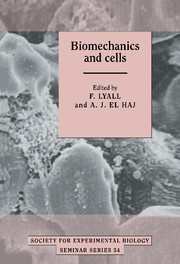Book contents
- Frontmatter
- Contents
- List of contributors
- PART 1 SOFT TISSUE
- PART 2 HARD TISSUE
- Cellular modelling of mechanical interactions with the skeleton
- Mechanical and hormonal influences in vivo cause regional differences in bone remodelling
- Mechanically sensitive cells in bone
- Mechanical stress and bone development
- Application of homogenous, defined strains to cell cultures
- Role of arachidonate in load transduction in bone cells
- Effects of mechanical stretch on actin polymerisation in fibroblasts of the periodontium
- Modulation of cartilage extracellular matrix turnover by pulsed electromagnetic fields (PEMF)
- Index
Cellular modelling of mechanical interactions with the skeleton
Published online by Cambridge University Press: 19 January 2010
- Frontmatter
- Contents
- List of contributors
- PART 1 SOFT TISSUE
- PART 2 HARD TISSUE
- Cellular modelling of mechanical interactions with the skeleton
- Mechanical and hormonal influences in vivo cause regional differences in bone remodelling
- Mechanically sensitive cells in bone
- Mechanical stress and bone development
- Application of homogenous, defined strains to cell cultures
- Role of arachidonate in load transduction in bone cells
- Effects of mechanical stretch on actin polymerisation in fibroblasts of the periodontium
- Modulation of cartilage extracellular matrix turnover by pulsed electromagnetic fields (PEMF)
- Index
Summary
Introduction
The role of exercise and mechanical stimuli in promoting soft tissue hypertrophy has been well studied, with many aspects covered in this volume; the role of exercise and mechanical loading in defining skeletal hypertrophy and remodelling has been less well characterised. In both tissues the mechanical events which occur during exercise can be analysed and modelled in a series of experimental manipulations in vivo and in vitro.
Lanyon, in a later chapter, outlines experiments to alter the mechanical environment in vivo and describes an elevation in bone modelling in response to a changing load environment. In parallel experiments, immobilisation and neurectomy is linked with disuse atrophy of the skeleton. This adaptation of bone can be defined as the formation and resorption of bone tissue in response to load in order to achieve the capacity for a specific mechanical function.
In vivo models allow loading responses to be monitored within the in situ three-dimensional bone matrix environment. However, these experiments can often pose difficulties in isolating specific cellular events occurring in complex tissues, relying heavily on technically demanding histological analysis of hard tissues. Such problems in treatment and isolation of cellular responses in vivo have hindered the progress in attempts to define the effects of loading on bone cell growth and differentiation. In vitro models offer different advantages; for example, effects on specific cells can be studied, a problem in the heterogeneous in vivo environment.
Information
- Type
- Chapter
- Information
- Biomechanics and Cells , pp. 147 - 163Publisher: Cambridge University PressPrint publication year: 1994
Accessibility standard: Unknown
Why this information is here
This section outlines the accessibility features of this content - including support for screen readers, full keyboard navigation and high-contrast display options. This may not be relevant for you.Accessibility Information
- 3
- Cited by
